Abstract
A crucial assurance for coal mine safety production, prevention and control, and rescue, which is the fundamental tenet of implementing intelligent coal mining, is the safety, stability, and quick transmission of coal mine roadways. However, because of the complex structure of the roadway environment, such as limited and variable space and numerous pieces of equipment, the wireless communication network is affected by the environment, the data transmission channel characteristics are complex and variable, and the existing data transmission methods are weak in adapting to the changing channel. These factors result in poor stability of the transmission of coal mine roadway environment detection data in the wireless communicative network. As a result, this article investigates the wireless communication systems’ real-time transmission in the intricate environmental setting of a coal mine. Based on the application of multiscale wavelet theory in data compression and reconstruction, an adaptive multiscale wavelet compression model based on the wireless data transmission channel is proposed, with an improved Huffman data compression coding algorithm derived from the multiscale wavelet, so that the environmental data meet the wireless communication channel transmission capability. The proposed algorithm boosts the compression ratio and adaptability of environmental data. A self-matching wavelet reconstruction algorithm is developed to achieve real-time and accurate data reconstruction following self-driven wavelet decomposition. The compression and reconstruction experiment performed during real-time wireless transmission of gas concentration data reveals that the original signal’s compression ratio reaches 74% with minor error and high fidelity. The algorithm provides the theoretical foundation for compression and reconstruction in complex coal mine environments for accurate, stable, and real-time data transmission. It is critical for ensuring reliable data transmission in safe production, prevention and control, rescue, and other operations, and it provides theoretical and technical support for intelligent coal mining.
1. Introduction
At the moment, coal is still the most cost-effective and reliable source of primary energy in China, and since 2020, relevant Chinese state authorities and research institutions have issued the Guidance on Accelerating the Development of Coal Mine Intelligence and the White Paper on the Framework of Top-Level Architecture and Standard System for Coal Mine Intelligence, which have promoted the deep integration of new-generation information technologies such as artificial intelligence, big data, cloud computing, and industrial Internet of Things, proposing an intelligent standard system for coal mines and putting forward higher requirements for the establishment of safe, reliable, efficient and stable underground coal mine communication networks [1,2]. More than 90% of coal mining operations in China are underground mines. The data collected by the roadway multi-sensor environmental monitoring system, which includes one-dimensional and two-dimensional data such as gas concentration, carbon monoxide concentration, carbon dioxide concentration, oxygen concentration, dust concentration, temperature and humidity, as well as video image information data, ensure environmental safety during the normal mining process in underground coal mines. However, factors such as the complex structure of underground coal mine tunnels and the complexity of the equipment space cause changes in the wireless data transmission channel characteristics in coal mine tunnels. As a result, achieving data fidelity transmission and studying data compression and reconstruction methods based on adapting to complex wireless data transmission channels becomes a critical issue in data transmission. However, the complex environment of underground coal mines has a significant impact on wireless communication network transmission capabilities; thus, the compression and reconstruction of the one-dimensional data becomes an important research element in solving the problems faced by data transmission technology under limited communication conditions.
There are increasingly mature data compression algorithms for underground coal mine environmental information available today. Yang S. et al. proposed a new generation of data collection methods for an energy internet based on compressed sensing, which improves data transmission and reconstruction accuracy [3]. Zheng W.Y. et al. proposed the use of the provenance compression algorithm to save network energy consumption and communication bandwidth [4]. Yang H. et al. proposed a data collection method for wireless sensor networks based on regionalized compressed sensing [5]. Aanchal et al. proposed optimal path selection for Huffman coding based on an ant colony algorithm and evaluated Huffman coding performance using four performance metrics: average residual energy, energy consumption, number of active sensors, and energy standard deviation [6]. Wu J.J. et al. proposed a Huffman model based on spatio-temporal difference thresholding, which improved the compression ratio of data to 30%, increased the life cycle of the network by 80% and reduced the mortality of nodes [7]. Zhai S. et al. proposed a data compression algorithm based on the correlation of data sequences in WSNs to reduce node data redundancy, compression ratio, compression error and communication energy consumption [8]. Zhu T.J. et al. proposed a wavelet-based adaptive multimode data compression algorithm, which effectively improves the compression ratio and reduces the energy consumption of the network [9]. Liu Z.Z. et al. investigated the relationship between network chunking and node deployment and proposed an adaptive block compression-aware data collection strategy for efficient large-scale data processing, reduced network traffic and network task latency, and balanced network node energy consumption [10]. Ebrahimi et al. proposed the joint application of Compression Sensing (CS) and Network Coding (NC) to achieve a 30% improvement in overall performance by addressing the uniform distribution of data across the network nodes and extending the network lifetime [11]. To address the problem of large volume and the difficult transmission of real-time monitoring data, Russell M. et al. proposed a data compression method combining Deep Convolutional Autoencoder (DCAE) with local structure and physical information loss terms, as well as a reconstruction method based on Fault Division Autoencoder Multiplexing (FDAM) [12]. Tagne Fute E. et al. proposed a raw data integrity compression and aggregation method that discards a certain number of information packets and retains only the most meaningful and informative ones to reduce redundant data and achieve optimal data transmission, as measured by compression ratio (CR), data aggregation ratio (AR), peak signal-to-noise ratio (PSNR), mean square error (MSE), and energy consumption (EC) performance metrics [13]. Zhang Y. and others proposed a hybrid compression coding algorithm based on wavelet transformation, improving wavelet, and its improvement algorithm to solve data compression in network environments such as big data and narrow bandwidth [14,15,16]. Pal S. et al. studied the embedded data compression algorithm that manages big data, effectively improving real-time data acquisition and reduction and achieving a 70% compression ratio combined with Huffman lossless coding [17]. Abraham B. et al. studied behavioral data clustering methods based on dictionary compression, improving the storage and transfer of large data quantities in an infinite space, achieving a better compression ratio with the mean squared error of shallow minimum phase divergence, et al. [18]. Davut I. et al. studied species data compression strategies and proposed a novel mathematical planning framework for maximizing Wireless Sensor Networks (WSNs) that effectively mitigate energy dissipation properties and make relay nodes transmit less data volume [19]. Mjp A. et al. investigated different schemes based on source and channel coding, multicast and distributed streaming to improve quality of service (QoS) and quality of experience (QoE) in multimedia communications over cognitive radio networks (MCRNs) [20].
In general, when transmitting data in a wireless communication network, the wireless communication channel is built to meet the optimal transmission characteristics of transmission bandwidth, transmission rate, fault tolerance, and network topology, and the external and equipment influencing factors are relatively constant so that no data are lost due to changes in channel transmission characteristics when entering the channel. However, the complex, uneven structure and limited space of underground coal mine tunnels, as well as the presence of many mobiles and fixed devices, have a significant impact on the transmission bandwidth, transmission rate, fault tolerance, and network topology of underground coal mine wireless communication channels, making the operation of their rated parameters challenging to guarantee. As a result, investigating key technologies such as data compression, reconstruction, and coding of 1D data in coal mine roadways with limited communication channels is at the heart of resolving the problem of real-time transmission of 1D data, such as environmental information in underground coal mine wireless communication systems.
However, there are few algorithms for data compression under a limited communication network in the complex environment of the coal mine roadway. Therefore, studying the data compression algorithm is necessary to adapt to the changing communication channel characteristics in the coal mine roadway. In this paper, we will propose a self-derived wavelet compression algorithm based on the theoretical basis of data compression and reconstruction with the help of multiscale wavelet theory to achieve self-derived compression depths for one-dimensional data such as environmental information, which significantly improves data compression capacity and adaptive capability of data transmission in different communication network environments; and establish a fast reconstruction algorithm matching the proposed algorithm. It improves the efficiency of Huffman coding and the ability of compressed data to adapt to the network environment when combined with Huffman coding to compress the decomposed signal, enabling data transmission to ensure real-time transmission while maintaining relatively good lossless transmission characteristics, providing a guarantee for the safe, reliable, and stable transmission of one-dimensional data such as environmental information.
2. Self-Derived Wavelet Data Compression and Reconstruction Algorithm Model of Wireless Data in Complex Spaces of Coal Mine Roadways
The algorithm is the compression coding of one-dimensional data such as environmental information after mastering the propagation characteristics of the wireless communication system in the coal mine roadway to ensure that the data can meet the communication channel transmission capacity when entering the communication channel. The algorithm mainly studies the compression characteristics of wavelet change under different decomposition stages. It determines the threshold of wavelet decomposition stages by taking the wireless communication system’s signal strength and other characteristics as the feedback value. The corresponding wavelet decomposition series is selected to compress the data and Huffman coding is carried out when the feedback value is in a specific interval. The obtained symbol set order list is sent to the sink through the channel, and the code value obtained by Huffman decoding the obtained signal information at the sink. The self-matching wavelet reconstruction algorithm is studied, and the corresponding wavelet inverse transform achieves lossless data reduction. This adaptive wavelet data compression coding and reconstruction algorithm in complex channels is called the self-derivative wavelet compression coding and reconstruction algorithm. The derived wavelet data compression algorithm structure and signal data transmission diagram are shown in Figure 1.
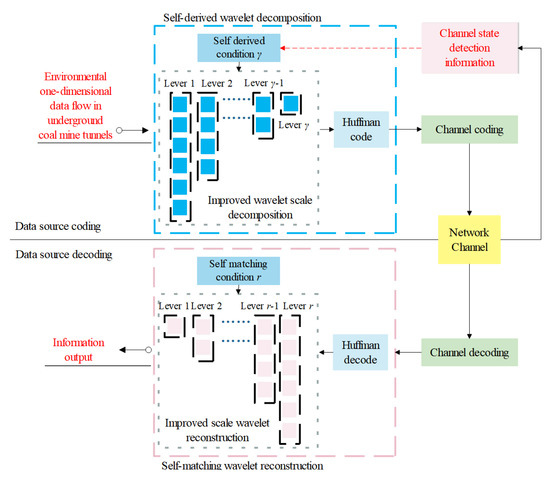
Figure 1.
Structure and reconstruction algorithm for self-derived wavelet compression coding in underground coal mine tunnels.
3. Design of the Self-Derive Wavelet Data Compression Algorithm
3.1. Analysis of the Derivative Algorithm
A self-derive characteristic means that under the influence of different external environmental conditions, the data compression algorithm derives the wavelet compression depth based on the channel characteristics to meet the transmission capacity of the wireless communication channel. Based on the channel characteristics such as the signal strength of the wireless communication system detected in real-time, selecting the data compression level suitable for channel capacity is significant for data transmission in the complex environment of coal mine roadways. A flow chart of self-derived characteristics is shown in Figure 2.

Figure 2.
Flow chart of self-derived characteristics.
In the complex environment of the underground coal mine, through the analysis and detection of the signal intensity E in the network state, the channel capacity change state Q is obtained. The real-time channel capacity Q is divided into different channel capacity interval sets I according to the principle of data transmission. The data compression level n of channel capacity is derived adaptively according to different intervals in the set to determine the scale series of multiscale wavelet data compression.
Assuming that an information symbol set with an amount of information is generated at the signal generator output, the average signal power of the transmission information U is S and the noise power in the unit frequency band is N0, the signal-to-noise ratio of the signal is ρ by:
When the signal strength e is affected by external noise interference, resulting in the continuous reduction of the average signal power S, the signal-to-noise ratio ρ also decreases.
According to Shannon’s theorem, the relationship between channel capacity and channel bandwidth and signal-to-noise ratio is:
where represents the spectral efficiency of channel transmission information, that is, the amount of information that can be transmitted per unit time and unit bandwidth, and the unit is bit/(Hz·s).
According to Formula (2), when the wireless communication equipment circuit has been designed or debugged and fixed, the channel bandwidth W is the specified value. In the process of signal transmission, when the signal strength E decreases and the signal power S changes, the channel transmission capacity will change. However, this change will cause more data to be transmitted in a narrow channel, resulting in instability and distortion. Therefore, the relationship formula between channel capacity Q and derived level n is:
Since the channel capacity Q is a physical quantity that is difficult to observe and detect, a relationship formula with the derived level n is established by using the signal strength E that is easy to observe and detect. The attenuation rate is assumed to be α, then the signal attenuation ratio η is:
Therefore, we can establish the relationship between set I and derived level n as:
where, the n is always taken as 0.1n, close to the smallest integer of the value.
3.2. Design of One-Dimensional Multiscale Wavelet Decomposition Algorithm Based on the Self-Derive
In this paper, the information acquisition signal of a complex environment in the coal mine is compressed to make the signal transmit safely and reliably in the limited and changing wireless communication channel. The self-derived wavelet signal decomposition algorithm is constructed with one-dimensional multi-order wavelet theory.
Assuming that the signal function is , according to the wavelet decomposition method of the orthogonal scaling function, for arbitrary , the signal function is , . There is:
where, the 2n and 2n+1 transformation coefficient of the L-th subband of the J-level wavelet hierarchy is:
Among them, , .
Based on the analysis of derivative characteristics and in combination with Formulas (7) and (8), the corresponding series of multilevel decomposition is determined by the independent variables in Formula (6) during the process of self-derivative wavelet decomposition. Therefore, assuming that the independent variable in Formula (6) is γ, the wavelet decomposition series is:
When the signal intensity information of the communication network state is fed back to the compression algorithm by the wireless communication system, the wavelet decomposition series J changes with the signal intensity variation coefficient γ to adapt to the channel capacity and data transmission rate to stably transmit the field detection data collected by the coal mine rescue robot with the maximum channel capacity. Therefore, the multilevel decomposition process of the self-derived wavelet compressed data information is shown in Figure 3.

Figure 3.
Multi-level decomposition process of self-derived wavelet compression data information.
The compressed data that eventually enters the wireless communication network is the approximate sequence of the lowest layer, i.e., the low-frequency part of the final subspace, all the detailed sequences of the compression process, and the high-frequency part of the subspace at all levels, as shown in Figure 4, which is a schematic diagram of the data flow into the channel after compression.

Figure 4.
Schematic diagram of the data flow coming into the channel after compression.
4. Reconstruction Algorithm Based on Self-Matching Wavelet
The self-matching wavelet reconstruction algorithm refers to restoring the data information after the source information is compressed and encoded by the self-derived wavelet and transmitted to the upper decoding and reconstruction end through the wireless communication network channel.
Self-derived wavelet compression encoding gives the derived properties of the data compression process, when the data are decoded and reconstructed, the decomposition level first needs to match the derived properties. The resulting data stream is encoded by the Huffman coding algorithm and then transferred into the channel for transmission after compression by self-derived wavelet data decomposition. Some of the redundant information in the data has been removed in the self-derived wavelet data decomposition algorithm, so the data are coded in the Huffman coding process, improving coding efficiency and reducing coding complexity. Analyzing the pre-processing data algorithm prior to Huffman coding is thus an essential means of improving the Huffman coding compressed data. The flowchart of self-matching wavelet reconstruction and decoding algorithm is shown in Figure 5.

Figure 5.
Flow chart of the self-matching wavelet reconstruction and decoding algorithm.
First, the compressed data information W’ is transmitted to the upper computer through the channel, and the receiver receives the information data. Secondly, the compressed information W’ enters the Huffman decoder and expands the data to obtain the decoded data stream. Then, by identifying the matching coefficient r as the derived characteristic coefficient γ, the reconstructed wavelet series is obtained. Finally, through the corresponding wavelet reconstruction algorithm, the data information flow is restored and the data V’ is obtained.
That is:
When the reconstruction coefficient r is determined, the reconstructed signal f(x) is:
Using the multilevel wavelet scaling relation, available:
Thus:
Available by Formulas (6)–(8):
where, h(s) is the pulse response of the reconstructed low-pass filter, g(s) is the pulse response of the reconstructed high-pass filter. The flowchart for self-matching wavelet reconstruction is shown in Figure 6.

Figure 6.
Flow chart of self-matching wavelet reconstruction.
5. Results
To improve the transmission algorithm of wireless data information in the complex environment of the underground coal mine, improve the speed of data compression coding in complex channel environment and the adaptability, to ensure the optimum state of the communication network and the validity of data transmission of environmental information. The performance evaluation indexes of the data compression algorithm mainly include compression ratio and compression error.
5.1. Data Compression Experiment and Analysis in the Variable Channel Characteristic Communication Environment
When the wireless communication system is relatively stable, the characteristics of the wireless communication channel in the roadway change due to fluctuations in the amount of communication data and changes in the external environment. The analysis curve of the self-derived wavelet data compression coding and reconstruction algorithm of gas data in the case of channel change is shown in Figure 7, Figure 8 and Figure 9 and Table 1.
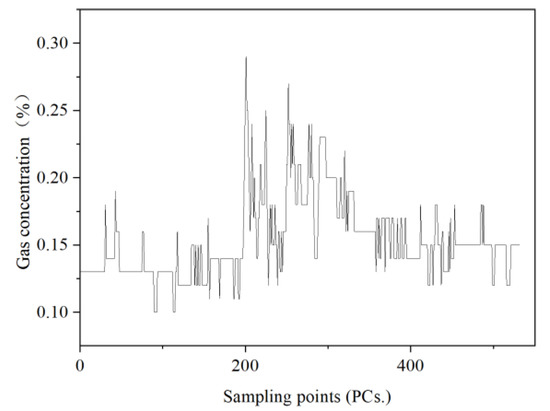
Figure 7.
Gas data original signal.
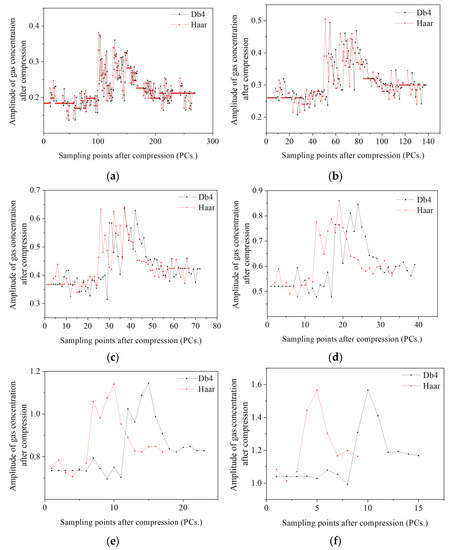
Figure 8.
Multistage wavelet compression signal. (a) Level-1 decomposition, (b) Level-2 decomposition, (c) Level-3 decomposition, (d) Level-4 decomposition, (e) Level-5 decomposition, and (f) Level-6 decomposition.

Figure 9.
Multi-level wavelet reconstruction signal. (a) Level-1 reconstruction, (b) Level-2 reconstruction, (c) Level-3 reconstruction, (d) Level-4 reconstruction, (e) Level-5 reconstruction, and (f) Level-6 reconstruction.

Table 1.
Changes in the Amount of Huffman Coding Information (Kb).
Figure 8 shows the multilevel wavelet decomposition results when the wavelet bases are DB4 and Haar. We can obtain the following findings:
- (1)
- With the first-order wavelet decomposition, the signal decomposition based on DB4 and Haar wavelet basis is almost the same, and the compression of the original signal is almost half;
- (2)
- With 2, 3, 4, 5 and 6-level wavelet decomposition, the signal decomposition gap based on DB4 and Haar wavelet base gradually becomes more considerable. When the decomposition level is higher, the signal decomposition details based on the DB4 wavelet base are more than those of Haar wavelet decomposition at the same level. Still, the amount of compressed data are more considerable;
- (3)
- On the contrary, with the increasing number of signal compression decomposition stages, the signal detail feature compression based on Haar wavelet is greater. Still, the data compression ratio is more considerable.
According to the information change results of Huffman coding after decomposition of multilevel wavelet when the wavelet base is DB4 and Haar in Table 1:
- (1)
- Without wavelet compression, Huffman coding has an obvious reduction in a large amount of data;
- (2)
- After wavelet decomposition based on the DB4 and the Haar wavelet basis, data compression is slight. It can be seen that some redundant information in the data has been compressed during wavelet decomposition, resulting in small changes in the amount of re-compressed data during coding;
- (3)
- At this time, the complexity of data transmission is reduced by Huffman coding on the premise of avoiding the loss of information details.
Figure 9 shows the multilevel wavelet reconstruction results when the wavelet bases are the Db4 and the Haar. We can obtain the following findings:
- (1)
- The gap between the results of multilevel signal reconstruction based on the DB4 and the Haar wavelet base is gradually smaller, which indicates that the degree of data restoration is relatively high;
- (2)
- Combined with the decomposition characteristics of multilevel wavelets shown in Figure 8 when the wavelet base is the Db4 and Haar, it can be concluded that the details are well preserved after compression based on the DB4 wavelet base, resulting in a large, compressed data wave flow;
- (3)
- After compression based on the Haar wavelet basis, fewer details are retained, resulting in less compressed data wave flow. The data restoration is near after multilevel reconstruction based on the two wavelet bases.
5.2. Data Compression Performance Experiment and Analysis
Through the data compression of the measured gas data from a mine, combined with the analysis of data compression performance in the previous paper, the compression performance parameters shown in Table 2 and Table 3, Figure 10 and Figure 11 were obtained.

Table 2.
Measured gas data compression ratio performance (%).

Table 3.
The measured gas data reconstruction effect (ERR).
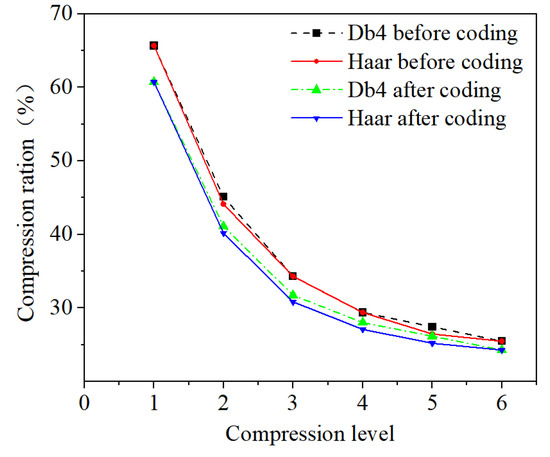
Figure 10.
Plot of the multiscale wavelet decomposition under different series.
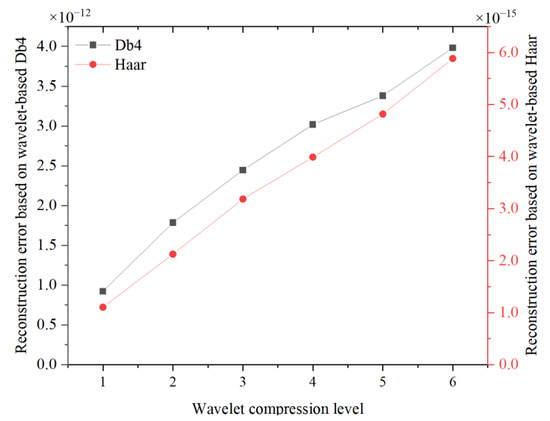
Figure 11.
Gas data reconstruction renderings.
5.2.1. Compression Ratio
According to the improved Huffman coding compression algorithm of self-derived wavelet, it can be seen that in the process of different compression levels, the compression ratio decreases with the increase in compression level. Combined with Table 2 and Figure 10, it can be seen that the compression ratio of data to be locked before coding is larger than that after coding. At the same time, Huffman coding can reduce the data complexity and the amount of data. The compression algorithm proposed by us realizes that under the condition of limited and changing wireless communication transmission characteristics, the compression process changes with the change of channel characteristics, realizes the stable transmission of real-time data, reduces the channel blocking caused by a large amount of data in limited channels, and prevents the loss of data. At the same time, it can be seen from Table 2 that in the process of data compression, the compression ratio is improved after coding, which reduces the data complexity and increases the compression ratio. The compression algorithm has a better application effect in the complex underground communication environment of the coal mine.
5.2.2. Reconstruction Effect
As shown in Table 3 and Figure 11, it can be concluded that when the change of wireless communication channel characteristics affects the wavelet decomposition series of data compression, there will be errors in data reconstruction in the channel. However, according to the results of error calculation, the error of data reconstruction after compression calculation is relatively small. In the process that the amount of real-time data increases gradually with the acquisition, the multi-scale wavelet decomposition algorithm under the self-derivation characteristics continues to adapt to the transmission characteristics of the wireless communication channel, and the error changes with the data transmission. Therefore, the data reconstruction needs a high degree of reduction. The algorithm meets the requirements of underground information acquisition and data safe communication. The effect of multilevel signal reconstruction based on the DB4 and the Haar wavelet basis is similar. Compared with the original signal, the distortion of the reconstructed signal is very small. However, compared with the two, the data reconstruction effect error based on the Haar wavelet basis is smaller than that based on the DB4 wavelet basis. Therefore, the reconstruction effect based on the Haar wavelet basis is better.
The data compression ratio and reconstruction effect results show that in the compression process of the two general wavelet bases, the data compression characteristics based on the Haar wavelet base are better than those based on the DB4 wavelet base. Therefore, in the one-dimensional data self-derived compression algorithm proposed in this paper, the Haar wavelet base will be used as the wavelet base in the process of the multi-scale wavelet decomposition.
5.3. Performance Experiment and Analysis of the Self-Derived Compression and Reconstruction Algorithm
Based on the data collected in the underground field environment of the coal mine, the influence experiment of the change of channel characteristics on the self-derived characteristics of the data compression algorithm during the collection time was designed. Assuming that the channel changes many times in the environment, the collected data compression effect is shown in Figure 12, the change in the amount of information in the Hoffman code after each level of decomposition is shown in Table 4.
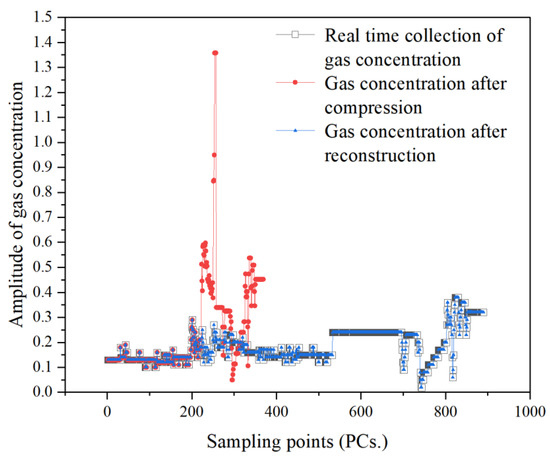
Figure 12.
The self-derived compression and reconstruction result.

Table 4.
Changes in the Amount of Huffman Coding Information after all-level decomposition (Kb).
It can be seen from the experimental results that under the complex channel characteristics, the response of data compression is obvious, and the compression level responds three times. Under good channel characteristics, the signal data can be transmitted completely. The data can be compressed at the corresponding level if the channel changes. In the compression of each part, the channel characteristics are reasonably used. In complex channels, the compression ratio of the original signal reaches 74%. The data are further compressed to a 68% compression ratio through the coding algorithm, reducing the data complexity. As shown in Figure 12, the data after signal reconstruction are slightly different from the original data. At this time, the reconstruction effect error is 2.9580 × 10−15, which is between 2~3 levels of fixed wavelet series compression. Therefore, the self-derived wavelet decomposition algorithm is more suitable for the underground wireless transmission characteristics of the coal mine, resulting in significant data loss and distortion, negatively impacting real-time monitoring in underground coal mine production sites. This has a negative impact on the real-time monitoring of underground production and poses a significant risk to coal mine safety.
6. Conclusions
In this chapter, we study the performance and evaluation methods of environmental data transmission in underground coal mines and present an improved Huffman data coding algorithm with self-derived multi-scale wavelet decomposition for environmental information under complex communication channel conditions. The theoretical analysis and experimental results of gas data compression in a mine show that the improved Huffman data coding algorithm model with self-derived multiscale wavelet decomposition has adaptive data compression and transmission capabilities, which can be used as a theoretical basis for studying the data transmission characteristics of wireless communication systems in complex environments.
- (1)
- The selection of wavelet hierarchical decomposition is theoretically supported by self-derivative conditions in complex channel characteristic environments. It improves wavelet data compression adaptability in complex underground environments.
- (2)
- The more self-derived decomposition levels there are, the more detailed the signal decomposition based on Db4 wavelet basis is than the Haar wavelet details of the same level of decomposition, and the more compressed data there is. In contrast, as the number of signal compression decomposition levels increases, the Haar wavelet-based signal detail features are compressed more, and the data compression increases.
- (3)
- In complex channels, the original signal compression achieves a compression ratio of 74%. The data are further compressed using the coding algorithm to achieve a compression ratio of 68%. Aside from having a lower error than a fixed compression algorithm, the self-derived wavelet decomposition algorithm is better suited to the wireless transmission characteristics of a complex channel environment.
According to the requirements of coal mine safety production, the daily data volume of general coal mine roadway gas data can reach more than tens of thousands, and the data volume is even more significant if it is a high gas mine. Because the coal mine roadway contains 1D data such as carbon monoxide and oxygen in addition to gas, the overall data volume will be even more significant. Ensured real-time fidelity transmission of coal mine roadway environmental data is critical for safe coal mine production. A portion of the daily gas inspection data is used in this paper to study the compression and reconstruction algorithm over a local wireless communication channel. The algorithm proposed in this paper achieves the fidelity transmission of one-dimensional data in the underground coal mine tunnel in the changing wireless communication network channel, providing a guarantee for real-time monitoring of the coal mine tunnel environment and underground safety production.
Author Contributions
Conceptualization, X.X., H.M., Q.M. and G.Z.; methodology, X.X. and H.M.; validation, X.X. and C.W.; formal analysis, X.X.; investigation, X.X.; writing—original draft preparation, X.X.; writing—review, X.C., X.Z. and G.Z.; writing—editing, X.X.; supervision, Q.M., X.C., X.Z. and G.Z.; funding acquisition, X.X., H.M., X.C. and X.Z. All authors have read and agreed to the published version of the manuscript.
Funding
This study was funded by the National Key R&D Program for Young Scientists of China (No. 2022YFF0605300), the Key Project of the National Natural Science Foundation of China (No. 51834006) and the General Project of National Natural Science Foundation of China (No. 52174149, No. 51975468, No. 51875451).
Data Availability Statement
Not applicable.
Conflicts of Interest
The authors declare no conflict of interest. At the same time, the funders have provided the data collection platform, analysis platform and experimental platform in this thesis, which have played a decisive role in the successful completion of the relevant research content in this thesis.
References
- Wang, G. New technological progress of coal mine intelligence and its problems. Coal Sci. Technol. 2022, 50, 1–27. [Google Scholar]
- Wang, G.; Du, Y. Coal mine intelligent standard system framework and construction ideas. Coal Sci. Technol. 2020, 48, 1–9. [Google Scholar]
- Yang, S.; Tan, B.; Guo, J. A new data collection method based on compressed sensing for new generation energy internet. Renew. Energy Resour. 2022, 40, 952–958. [Google Scholar]
- Zheng, W.; Mao, J. Advancement of compression transmission techniques for WSN provenance. J. Jiangsu Univ. (Nat. Sci. Ed. 2016, 37, 572–577, 603. [Google Scholar]
- Yang, H.; Wang, X. Data Gathering Based on Regionalized Compressive Sensing in WSN. Chin. J. Comput. 2017, 40, 1933–1945. [Google Scholar]
- Kumar, S.; Kaiwartya, O.; Abdullah, A.H. Green computing for wireless sensor networks: Optimization and Huffman coding approach. Peer-Peer Netw. Appl. 2017, 10, 592–609. [Google Scholar]
- Wu, J.; Zhu, R.; Zhong, Z. Based on a Spatio-temporal Differential Threshold Huffman Data Compression. Comput. Meas. Control 2019, 27, 273–277. [Google Scholar]
- Zhai, S.; Qian, Z.; Liu, X.; Sun, D. Data Compression Algorithm Based on Sequence Correlation for WSN. J. Electron. Inf. Technol. 2016, 38, 713–719. [Google Scholar]
- Zhu, T.J.; Lin, Y.P.; Zhou, S.W.; Xu, X.L. Adaptive multiple-modalities data compression algorithm using wavelet for wireless sensor networks. J. Commun. 2009, 30, 48–53. [Google Scholar]
- Liu, Z.; Cheng, X.; Zhang, Y.; Peng, H. Data Collection Method of Large Scale WSNS Mobile Node Based on Compressed Sensing and Intelligent Optimization. J. Northwest. Polytech. Univ. 2020, 38, 333–340. [Google Scholar] [CrossRef]
- Dariush, E.; Chadi, A. Network Coding-Aware Compressive Data Gathering for Energy-Efficient Wireless Sensor Networks. ACM Trans. Sens. Netw. 2015, 11, 1–24. [Google Scholar]
- Russell, M.; Wang, P. Physics-informed deep learning for signal compression and reconstruction of big data in industrial condition monitoring. Mech. Syst. Signal Process. 2022, 168, 108709–108723. [Google Scholar] [CrossRef]
- Tagne Fute, E.; Kamdjou, H.M.; El Amraoui, A.; Nzeukou, A. DDCA-WSN: A Distributed Data Compression and Aggregation Approach for Low Resources Wireless Sensors Networks. Int. J. Wirel. Inf. Netw. 2022, 29, 80–92. [Google Scholar] [CrossRef]
- Li, C.; Li, P.; Song, Z.; Wang, H. Novel method of process data compression based on lifting scheme. J. Zhejiang Univ. (Eng. Sci.) 2006, 40, 371–375. [Google Scholar]
- Rui, Z.; Wen, B.; Xiao, Y. Data Compression Method Based on Lifting Wavelet Transform and Hybrid Entropy Coding. Autom. Electr. Power Syst. 2007, 31, 65–69. [Google Scholar]
- Yu, P.; Ma, X.; Chen, H. The Encoding Algorithm of Seismic Data Compression Based on Lifting Wavelet Transform. J. Suzhou Univ. (Eng. Sci. Ed.) 2009, 29, 7–11. [Google Scholar]
- Pal, S.; Das, I.; Majumder, S.; Gupta, A.K.; Bhattacharya, I. Embedding an Extra Layer of Data Compression Scheme for Efficient Management of Big-Data. In Information Systems Design and Intelligent Applications; Springer: New Delhi, India, 2015; pp. 699–708. [Google Scholar]
- Abraham, B.; Paul, V.; Abraham, N.J. Dictionary Based Behavioural Data Compression: A Clustering Approach. Middle-East J. Sci. Res. 2015, 23, 214–218. [Google Scholar]
- Incebacak, D.; Zilan, R.; Tavli, B.; Barcelo-Ordinas, J.M.; Garcia-Vidal, J. Optimal data compression for lifetime maximization in wireless sensor networks operating in stealth mode. Ad Hoc Netw. 2014, 24, 134–147. [Google Scholar] [CrossRef]
- Piran, M.J.; Pham, Q.V.; Islam, S.R.; Cho, S.; Bae, B.; Suh, D.Y.; Han, Z. Multimedia communication over cognitive radio networks from QoS/QoE perspective: A comprehensive survey. J. Netw. Comput. Appl. 2020, 172, 102759. [Google Scholar] [CrossRef]
Publisher’s Note: MDPI stays neutral with regard to jurisdictional claims in published maps and institutional affiliations. |
© 2022 by the authors. Licensee MDPI, Basel, Switzerland. This article is an open access article distributed under the terms and conditions of the Creative Commons Attribution (CC BY) license (https://creativecommons.org/licenses/by/4.0/).